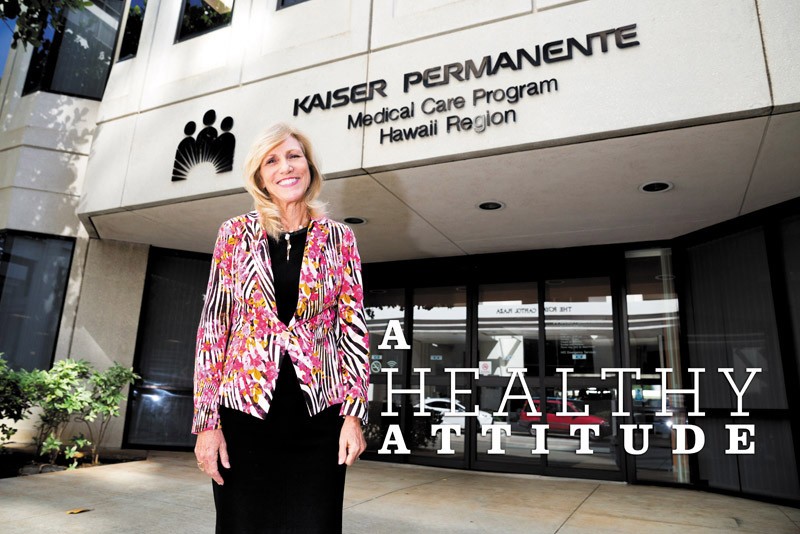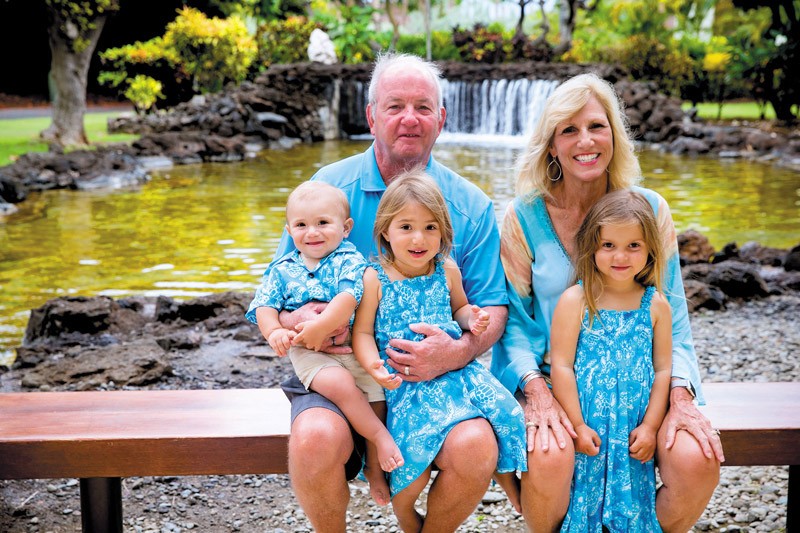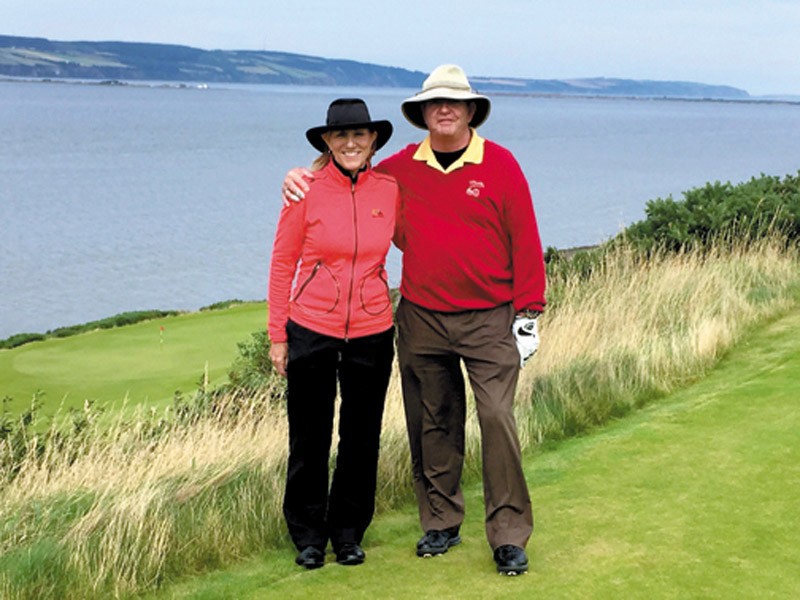A Healthy Attitude

Hawaii president of Kaiser Foundation hospitals and health plan Mary Ann Barnes
Is our health care system sick?
Its symptoms are acute, plagued by anemic attempts at reform, crippling regulatory mandates and general malaise about sustainability for the future.
Health care leaders know they must step up to inspire and facilitate remedies to spur its recovery.
But doing so in the face of mounting economic, social and legislative pressures – plus the changes at the White House – makes it a daunting task.
It is said that the United States approaches public health backward. Our current health care system is set up to treat people after they are sick rather than keeping them well in the first place.
Hence, our country has a sick care system rather than a health care system.
The Trust for America’s Health reports that more than half of Americans are living with one or more serious, chronic diseases, which could have been prevented proactively. It also predicts today’s children are on track to be the first in U.S. history to live shorter, less healthy lives than their parents.

Mary Ann Barnes and husand Rick Buckrop with their three grandchildren PHOTOS COURTESY MARY ANN BARNES
It’s enough to make you sick.
How do we turn the tide of this trend?
Visionary Voice
At Kaiser Permanente Hawaii, the visionary voice belongs to Mary Ann Barnes, R.N., M.S.N., president of Kaiser Foundation hospitals and health plan. Starting in this role in June 2014, she leads the second largest health plan in Hawaii, serving 250,000 members and employing more than 4,400 staff and clinicians for its 278-bed hospital and 20 clinics.
Barnes joined Kaiser Permanente in 1974 as an intensive care unit nurse in San Diego and has held progressively responsible positions of leadership throughout California.
Barnes earned her B.S. in nursing from Arizona State University and an M.S.N. in administration from San Diego State University. She completed the Harvard Business School Executive Leadership Program and Stanford University’s Executive Business Program.
She has three children and three grandchildren, making health care at home and at work second nature.
Did she choose health care as a career, or did it choose her?
“I chose it,” Barnes replies. “Having the patient at the center of everything I do is my touch point.”

Barnes and Buckrop golfing in Scotland
Once careers for women were limited to nurse or teacher.
“I was captivated by health, wellness and healing,” she says. “I always looked from the standpoint of how I can make a bigger difference. It has served me well.”
Indeed it has. Today Barnes sits at the regional helm of a nearly 60-year-old enterprise with a storied past. Kaiser Permanente (KP) is regarded the nation’s pioneer in pre-paid industrial insurance and integrated managed care.
Industrial Icon
KP evolved from private health care coverage for industrialist Henry J. Kaiser’s construction, shipyard and steel mill workers during the late 1930s and 1940s. Kaiser and physician Sidney Garfield formed an insurance consortium to meet workers compensation obligations.
The industrial indemnity prepaid 17.5 percent of premiums to cover work-related injuries, while workers contributed 5 cents per day to cover non-work-related injuries. Workers who find themselves in a work-based accident would be represented by local employee-focused law firms similar to Baird Quinn LLC and other services that focus on workers’ compensation.
The plan eventually expanded to include dependents, making a major shift from industrial medicine to family practice. In 1945, the plan was open to public enrollment.
Today KP, headquartered in Oakland, California, serves 10.6 million members and is one of the nation’s largest notfor-profit health plans.
It is comprised of three entities: Kaiser Foundation Health Plan Inc. (KFHP), Kaiser Foundation Hospitals, and Permanente Medical Groups of physicians.
Operating in seven U.S. regions including Hawaii, it is the largest managed care organization in the country.
View From The Top
From this vantage point, Barnes has an insightful view of where health care is and where it is headed. We ask her for a pulse of the situation.
“The Affordable Care Act certainly put health care on its head,” she begins. “We’ve been sorting out what the rules are, but that could change with the new (governmental) administration. We’re waiting to see what happens.
“We need to be flexible and prepared,” she asserts. “Yet the focus must continue to be on affordability, access to care and quality of services.”
The “how” of each premise drives lively discussion and debate inside and outside of the medical field.
But it must be sorted out, according to Barnes, because providers, payers and patients – not Supreme Court judges who interpret the rules – must be the true agents of change.
Barnes gauges the impact of change against the uniqueness of Hawaii.
“We must look at what fits best with our culture here,” she says.
Critical issues such as the disparity of services on the Neighbor Islands, huge physician shortage particularly in primary care, and case management for chronic disease are high on the priority list.
“We’ve had growth on the Neighbor Islands, adding a clinic in Kona two years ago and opening our first clinic on Kauai earlier this year. We will be taking over the Maui county hospital on July 1,” she says.
“We envision local hubs where people can get primary and specialty care with one-stop convenience,” she says.
“We have made a huge investment in technology in all facets of our operations,” Barnes points out. “We invest approximately 4-6 percent of revenue each year to maintain and increase health care technology. This includes updates to our industry-leading electronic medical record system (KP HealthConnect), and cutting edge diagnostic and treatment tools.” To help address the critical shortage of physicians here, KPH has a residency program that’s currently in its third year.
“As of today, we’re short about 500 physicians in the state,” she points out. “On Oahu, about a third of primary care physicians are not taking patients. It’s about access to care.
“There also are shortages in behavioral health (physicians, psychologists, social workers),” she says.
Optimism And Opportunity
“So there are some incredible opportunities in the state,” she suggests. “There are complexities in Hawaii being so isolated and diverse, but we are hopeful that community collaboration can bring good results.
“We all seek a healthier Hawaii – encompassing mind, body and spirit -from not only individuals but businesses and other stakeholders,” the KP executive heralds. “It must also permeate our community environment, supporting healthy habits in settings such as parks, walking paths and activity centers.”
This is what Barnes means when she positions herself and KP as total health champions. Spoken like a true integrated wellness guru.
Health systems like KP are strategically investing capital and resources into creating the futures they desire. These investments require research, intensive planning and tough decisions.
As Hawaii caters to an aging population and transitions to the next generation of health care providers, the leadership and wisdom of administrators such as Barnes will be called upon to make a difference for our community.
This is what her 40-plus years of experience have been preparing her for. There’s every indication that she passionately embraces the role.
After all, Hawaii has a reputation to uphold.
American Public Health Association consistently ranks Hawaii as the healthiest state in the nation. The Aloha State has been in the top six since 1990, largely for its low obesity rates and high mental health ratings.
We have our challenges from a systemic standpoint, but in general, we tend to be a healthy lot.
For that, we are grateful. So the next time a doctor nags you about not getting enough exercise, for instance, consider the lightheartedness of one islander, who recounts:
“My doctor took one look at my gut and refused to believe that I work out. So I listed the exercises I do every day: jump to conclusions, climb the walls, drag my heels, push my luck, bend over backward, run around in circles, put my foot in my mouth, go over the edge and beat around the bush.”
And if you ask us whether health care will be different in the next century, all we can say is, “We’re not sure, but if you call now, you might get an appointment by then.”
Laughter still is the best medicine.






